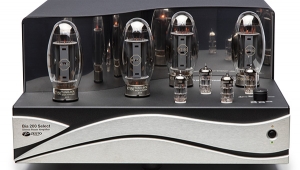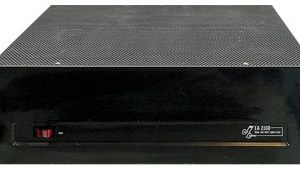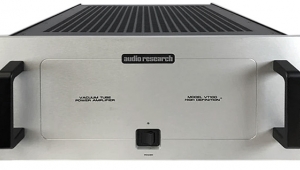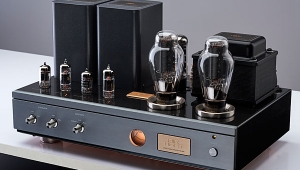| Columns Retired Columns & Blogs |
Cary Audio Design CAD-805 monoblock power amplifier Martin Colloms 5/94
Martin Colloms wrote about the CAD-805 in May 1994 (Vol.17 No.5):
Footnote 1: Speaking of single-ended amplifiers, it's worth noting the work of Paris-based Jean Hiraga at L'Audiophile over 10 years ago. He developed a single-ended, transformer-coupled transistor power amplifier called Nemesis, with no other active devices whatsoever other than a single power device (namely a 25SK 135 power FET). The Nemesis's utter simplicity helped it achieve a sound that closely approached that of a classic WE 300B single-ended triode amplifier.—Martin Colloms
My excitement grew as I stripped the wrapper from the first new, larger Stereophile (January 1994). First reactions were favorable: it was brighter, better presented, easier to read, and had more impact. I welcomed the change, even if it does mean my Stereophiles no longer fit on the old, narrow shelf on my bookcase where they once shared space with my digest-sized editions of Hi-Fi Choice.
There was so much to read that it took a while to come to grips with the magazine. Only a day or so after it arrived did I realize the significance of the front-cover legend posted over the mugshots of the Cary and Krell power amplifiers: "If either of these amplifiers is RIGHT...the other must be WRONG." Below this potentially damning statement was the controversial question, "Is the High-End Doomed?" If the headline proposition is true, then the answer to that question is, plainly, "Yes." And Stereophile could well be called to account in this respect.
Without in any way seeking to diminish Dick Olsher's informative review of the Cary CAD-805 single-ended tube amplifier, I submit that we have here a case of the "falling in love" phenomenon. Believe me, it's all too easy to fall in love with audio equipment when it elicits the right kind of emotional response when playing great music. But love affairs with audio gear rarely last as long as those with people. Eventually, that emotional response becomes increasingly familiar, weakening until it's possible for the listener to take notice of a new audio suitor.
Dick identified something in his review which many reviewers have been aware of for some time now: If you choose, either deliberately or by default, to focus your attention on one area of the audio spectrum—particularly the vital midrange—then magical, if limited, results are indeed possible. After all, the midrange is where most speech and music happens; the rest could be largely considered window dressing.
Consider the near-magical midrange purity of large, true ribbon or electrostatic transducers. The Quad electrostatic's overall midrange achievement is entirely comparable with that of a 211 or 300B triode amplifier operated in single-ended mode (footnote 1). There's no question that certain revelatory audio experiences can be sufficiently powerful to overturn one's entire set of beliefs about how high-quality sound should be achieved. As Dick states, in the characteristic voice of the newly converted, "Only once or twice in a lifetime does one come to such a fork in the audio road. I've taken route 805." And if you do direct your attention exclusively to the midrange, you'll eventually realize that mainstream hi-fi does miss out on ultimate realism. Once heard, it's hard to part company with such midrange magic. But part company the reviewer must, if a sense of balance and order is to be preserved.
If I were to focus solely on my positive reaction to the single-ended triode sound, I could not fairly review alternative technologies and convey the balance of their undoubted merits. I would be able to do nothing but state the obvious: "Single-ended triode midrange is much better, and damn the rest."
The High End embraces a wide range of technologies aimed at enhancing the listening experience of diverse people with equally diverse tastes in music, budgets, aspirations, standards, and listening environments. The Quad ESL-63's midrange may be wonderful—even more so, the original Quad—but this speaker is still not for everyone. If a reviewer starts to value just one aspect of reproduction, the entire balance and framework of the high-end audio industry is endangered.
Many people in the industry would readily acknowledge the attainment of the Cary 805 and its siblings. But how many of us would also forego state-of-the-art transparency, highly stable imaging, fine detail resolution under adverse drive conditions, broad-band neutrality, fine dynamics in the bass and treble, overall dynamic headroom, naturally dynamic bass foundation and slam, and tolerance of a wide range of loudspeaker preferences? Such things do matter, and if the subjective harmonic and tonal perfection of the single-ended triode can be obtained only by unduly compromising these other qualities, we must think again—if only because each individual will judge the relative value of these factors via his or her own criteria.
Consider the disappointment of test-driving the world's quickest-accelerating car, only to discover that it doesn't steer well and has poor brakes. Single-ended triodes will lead you to madrigals and string quartets with a renewed appreciation, but after a while you'll find that Laurie Anderson, Little Feat, Miles Davis, Stravinsky, Mahler, and Joe Cocker no longer figure on your CD playlist.
It's because of factors like these that I must refute January's front-cover headline.
There may be a number of fundamental audio truths implicit in a single-ended triode amplifier driving a genuine high-sensitivity speaker. Such truths deserve to be recognized, since their appreciation and understanding can help make all audio systems sound better in the long term.
For example, the ear has a single-ended characteristic: There's little doubt that the non-linear nature of a single-ended triode amplifier sounds consonant to the ear. Asymmetric low-order distortion is comparatively innocuous, and significantly high values—as much as 3%—can be tolerated. In addition, this type of amplifier enjoys a very short signal path, and this significantly influences aspects such as "palpability," "immediacy," and micro-dynamics.
Another aspect is feedback. It's now widely accepted that global negative feedback affects sound quality, especially tonal quality. This is true even when an amplifier's overall "black box" input/output characteristics are slightly altered by changes in internal feedback factor. While there are notable exceptions, low-feedback amps tend to sound sweeter, purer in both harmonic content and tonality. This is true even when the measured distortion in the higher-feedback designs is considered to be vanishingly small and, hence, supposedly inaudible.
The single-ended triode design has low, or even zero loop negative feedback. This has adverse consequences for frequency response, output impedance, and the speaker-load matched responses. These are compromises both the designer and the purchaser must learn to accept.
While the fairly high distortion levels of low-feedback single-ended amplifiers are marginally audible, I don't think that this alone unduly prejudices sound quality, nor do I think that the positive subjective reaction to these designs is due to some psychoacoustic enhancement or correction of existing signal distortion. My experience suggests that these amplifiers sound good in spite of their measurable and audible defects.
Loudspeakers play a part. It's long been understood that, all things being equal, high sensitivity is a primary virtue (footnote 2). Real increases in sensitivity directly result in wider dynamic range, superior dynamics, greater clarity, audibly lower distortion, and generally superior reproduction of rhythm. At the same time, the demand on the amplifier is reduced, thereby improving its own sound quality at the target sound-pressure level.
Put two and two together—a single-ended triode and a highly sensitive speaker—and you could easily get six! Conversely, sacrifices in stereo image performance, timing, bass slam, and overall neutrality are very likely. Where should we draw the line?
There is a way to move ahead. Free-market forces are at work here. High-end audio is a competitive, tightknit, specialist community of designers, entrepreneurs, dealers, and discerning customers—a community in which a healthy cross-fertilization of ideas occurs. The industry is constantly learning from its joint endeavors. It is a good idea to re-examine older techniques and their attainments, perhaps throwing a new light on them and helping to put present achievements in perspective. However, I've found little evidence to suggest that we should completely abandon the High End's present overall attainment for that near-magical midrange window.—Martin Colloms
Footnote 1: Speaking of single-ended amplifiers, it's worth noting the work of Paris-based Jean Hiraga at L'Audiophile over 10 years ago. He developed a single-ended, transformer-coupled transistor power amplifier called Nemesis, with no other active devices whatsoever other than a single power device (namely a 25SK 135 power FET). The Nemesis's utter simplicity helped it achieve a sound that closely approached that of a classic WE 300B single-ended triode amplifier.—Martin Colloms
Footnote 2: One must note the outstanding dynamic quality of high-sensitivity loudspeakers, such as the classic Klipschorns, which have stood the test of time.—Martin Colloms
- Log in or register to post comments



































